Thu 24 Dec 2020
A Western Movie Review by Dan Stumpf: A TIME FOR DYING (1969).
Posted by Steve under Reviews , Western movies[8] Comments
A TIME FOR DYING. Fipco, 1969/71/82. (*) Richard Lapp, Anne Randall, Robert Random, Audie Murphy, Victor Jory, Beatrice Kay, Burt Mustin, Peter Brocco, Walter Reed and Emile Meyer. Written and directed by Budd Boetticher.
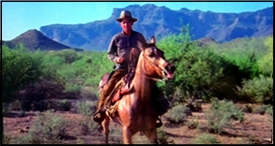
The last film of legendary westerners Audie Murphy and Budd Boetticher, and the best I can say is that it will probably do their reputations no lasting damage.
Murphy, of course, is remembered as the most decorated soldier of WWII (Neville Brand was the fourth most decorated.) and as the rather retiring hero of numerous westerns, some pretty good, including fine performances in THE UNFORGIVEN and RED BADGE OF COURAGE.
Budd Boetticher’s films are a mixed bag, but he hit his stride with a series of Randolph Scott Westerns, most of them produced by Harry Joe Brown, including SEVEN MEN FROM NOW, THE TALL T, COMANCHE STATION and RIDE LONESOME. Same Peckinpah’s RIDE THE HIGH COUNTRY is often seen as a continuation of the series and a fitting coda to Scott’s career.
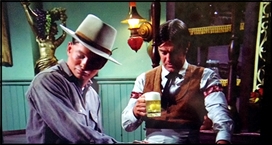
Boetticher’s subsequent career was notably rockier, including a lengthy exile in Mexico laboring to produce ARRUZA, which is only fair-to-middling, the screenplay for TWO MULES FOR SISTER SARAH, and this one, A TIME FOR DYING, which was plagued with money troubles during and after production — note the various release dates — probably because it isn’t very good.
Boetticher’s best work was spiced with the fiery Karen Steele and memorable baddies like Lee Marvin and Richard Boone, anchored by the authoritative presence of Randolph Scott at the films’ center. DYING offers some fine character actors, but they only serve to show up the inadequacies of the leading players, who never seem to relax into the natural performances that grace the earlier films.
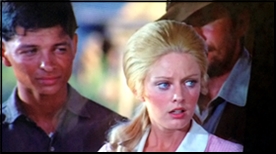
If you can get past this (and you can’t, really) you run into an uncharacteristically aimless screenplay from Boetticher. His films with Randolph Scott had a sense of movement (One critic called them “journey films.) with the characters and the story visibly progressing to a conflict defined early on. Or as another critic put it: “Partly metaphorical odysseys, partly floating poker games where every character took turns bluffing about his hand until the final shoot-out.â€
There’s movement in A TIME FOR DYING, but it’s mostly just Richard Lapp and Anne Randall (Never heard of them? See this and find out why.) bounced from one encounter to another without ever realizing their place in Boetticher’s existential universe. And the result is a story that meanders when it needs to move.
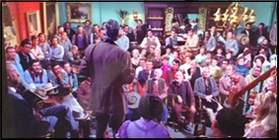
If there’s a saving grace, it’s Boetticher’s elliptical, near-poetic dialogue. Dialogue written to be spoken, not read. As in a Mexican stand-off:
BILLY: “That woman drop a hammer on me, it don’t make a damn what you do to her husband’s head.â€
But I’m afraid it’s just not enough. This is available free on Amazon Prime, and worth every penny, but if you’re inclined to see it, talk yourself down and watch RIDE LONESOME instead.
—
(*) From Wikipedia: A rough cut of the film premiered at the National Film Theatre in London on May 27, 1969. The finished version of the film premiered in Dallas, Texas on September 15, 1969. The film was shown throughout Texas, but following legal problems after Murphy’s death in 1971, the film only had limited showings and did not screen in New York until 1982.
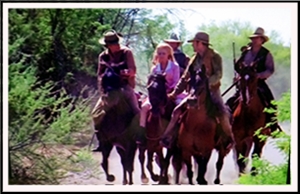
December 24th, 2020 at 1:07 pm
Budd Boetticher was a competent journeyman director with a big, self-aggrandizing mouth. No reason in the world for him to be legendary, and based on his work, he is not. Randolph Scott is legendary over thirty plus years. Not Budd. This veneration for Budd is probably a consequence of his self-promotion and the high falutin crowd who no longer go to the movies, but venerate cinema. Eeech!
December 24th, 2020 at 1:17 pm
Re Two Mules for Sister Sara: Albert Maltz wrote the screenplay, Budd the original story. A near awful film no matter the credits.
December 24th, 2020 at 5:43 pm
The four Westerns on which Boetticher’s reputation has largely been built–Seven Men from Now, Ride Lonesome, The Tall T, and Comanche Station–were all written by Burt Kennedy; he’s the real auteur of all those pictures, not Boetticher. I found it ironic that TCM’s Boetticher documentary was titled “A Man Can Do That”–which is a line of dialogue actually written by Kennedy and used in both Seven Men from Now and Ride Lonesome. Fort Dobbs, starring Clint Walker, was also written by Kennedy, but directed by Gordon Douglas; it feels much more of a piece with the four Scott films than the three non-Kennedy films that Boetticher directed for Scott (Decision at Sundown, Buchanan Rides Alone, Westbound). I can think of no better deflation of the auteur theory in general than to show someone Ride Lonesome, Fort Dobbs, and Westbound without showing them the opening credits, then asking them which of the two they believe were helmed by the same director.
December 24th, 2020 at 8:26 pm
I’m an auteurist. And I like both Boetticher and Kennedy.
My Best Film list includes these recommended Boetticher-directed works:
Seven Men from Now (Budd Boetticher, 1956)
One Mysterious Night,
Behind Locked Doors,
Horizons West,
Seminole,
The Man From the Alamo,
Wings of the Hawk,
The Tall T,
Decision at Sundown,
Buchanan Rides Alone,
Ride Lonesome,
Westbound,
The Rise and Fall of Legs Diamond.
Television series:
Public Defender: Think No Evil
The Count of Monte Cristo: The Affair of the Three Napoleons
Maverick: The War of the Silver Kings, Point Blank, According to Hoyle
Hong Kong: Colonel Cat
The Rifleman: Stopover
And for Kennedy:
Support Your Local Gunfighter (Burt Kennedy, 1971)
The Money Trap,
Hannie Caulder,
The Train Robbers.
Television series:
Lawman: The Long Gun; The Wanted Man; Cort
Simon & Simon: The List
December 24th, 2020 at 8:34 pm
If Kennedy is the true auteur, then why are his own movies so mediocre? My sense is that Scott, Kennedy and Boetticher had a special chemistry together, which is why their joint efforts are so superior to their individual films.
December 24th, 2020 at 8:50 pm
Definition: synergy. The interaction or cooperation of two or more organizations, substances, or other agents to produce a combined effect greater than the sum of their separate effects.
December 24th, 2020 at 8:42 pm
Scott’s presence creates a non-linear, non-intellectual value, indefinable other than as art. From his supporting part in Jesse James on, we can all see it.
December 24th, 2020 at 10:27 pm
One thing I think we can all agree on, this film does no favors to star or director, or pretty much anyone else involved with it. I feel sorry for anyone who sits through the whole thing.